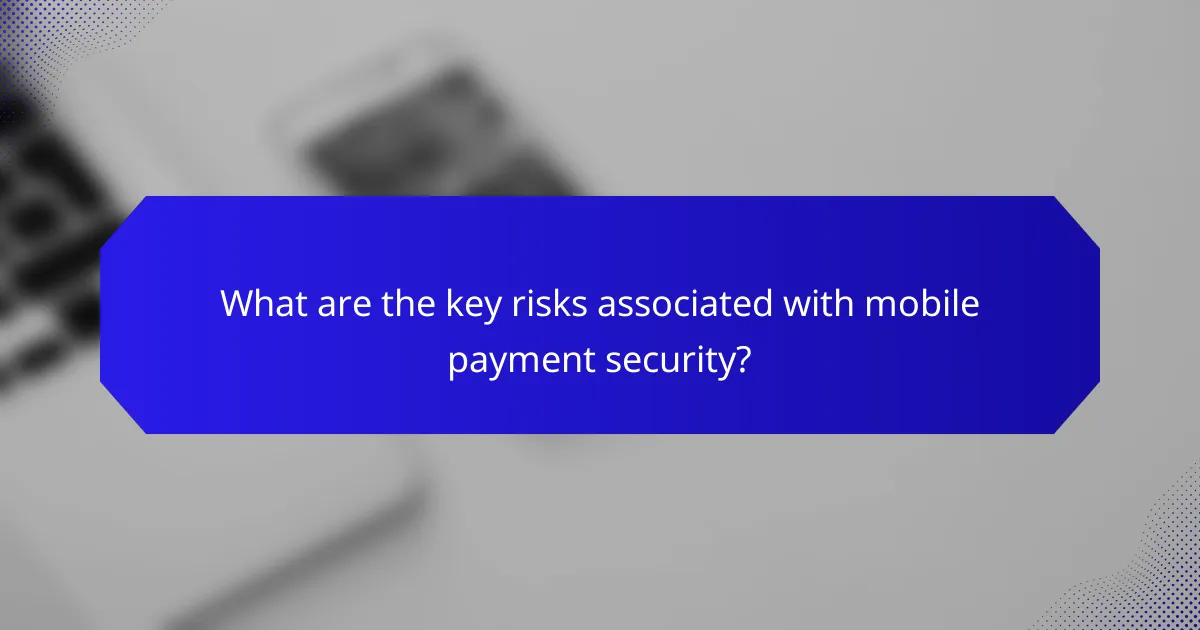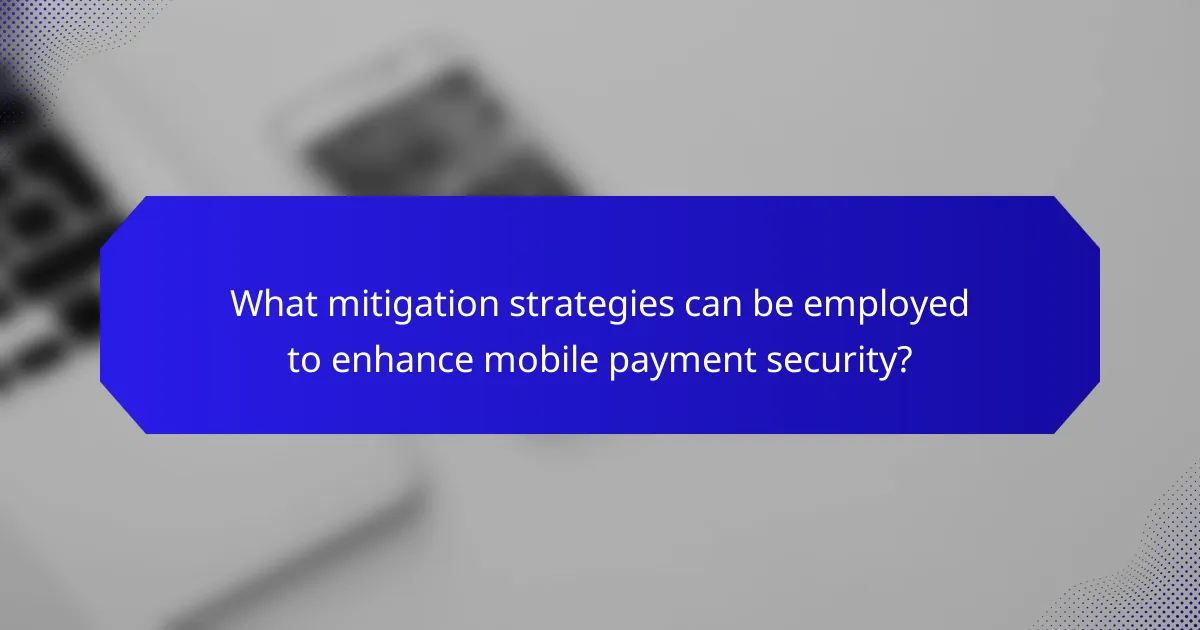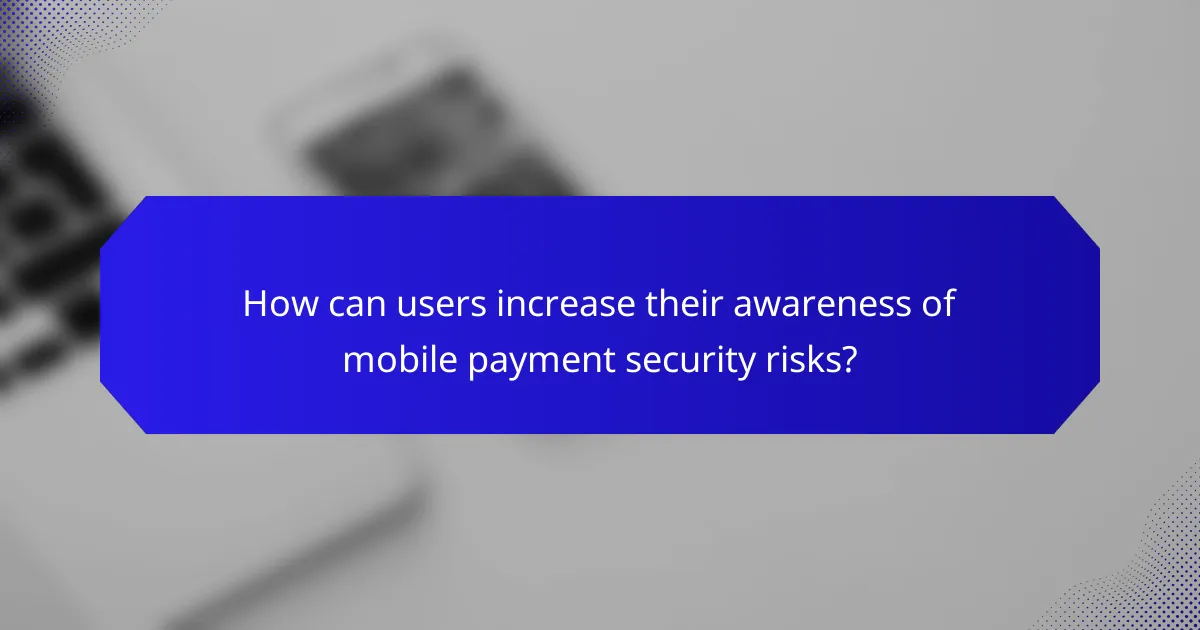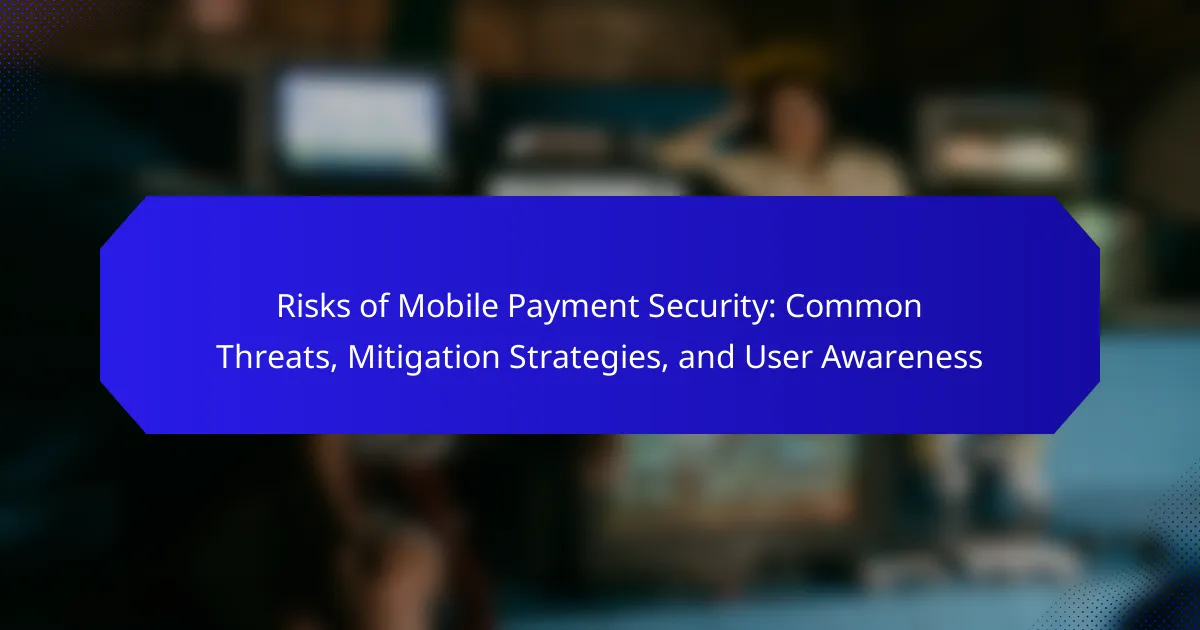Mobile payment security encompasses the risks and strategies associated with the use of digital payment systems. Key risks include data breaches, malware attacks, and phishing scams, which can lead to identity theft and financial loss. The article outlines the growing threat landscape, citing a 30% increase in mobile payment fraud complaints in 2022 and projecting significant costs from cybercrime by 2025. Essential mitigation strategies such as encryption, two-factor authentication, regular software updates, and user education are discussed to enhance security. Additionally, the importance of user awareness and proactive measures in recognizing and responding to potential threats is emphasized.

What are the key risks associated with mobile payment security?
The key risks associated with mobile payment security include data breaches, malware attacks, and phishing scams. Data breaches can expose sensitive financial information, leading to identity theft. Malware attacks target mobile devices to steal payment information or credentials. Phishing scams trick users into providing personal details through fraudulent messages or websites. According to a report by Cybersecurity Ventures, cybercrime is expected to cost businesses over $10 trillion annually by 2025, highlighting the urgency of addressing these risks. Additionally, a study from the Federal Trade Commission revealed that mobile payment fraud complaints increased by 30% in 2022, underscoring the growing threat landscape.
How do mobile payment systems operate and what vulnerabilities exist?
Mobile payment systems operate by enabling users to make transactions through their smartphones or other mobile devices. These systems typically utilize technologies such as Near Field Communication (NFC) and QR codes to facilitate payments. When a user initiates a payment, the mobile device communicates with a payment terminal or app, securely transmitting payment information.
Vulnerabilities in mobile payment systems include data interception, malware attacks, and insecure networks. Data interception can occur when sensitive information is transmitted over unsecured connections. Malware can compromise a device, allowing unauthorized access to payment information. Additionally, insecure networks, such as public Wi-Fi, pose risks by exposing data to potential hackers.
According to a report by the Federal Trade Commission, mobile payment fraud has increased significantly, highlighting the need for robust security measures. Regular software updates and user awareness are crucial in mitigating these vulnerabilities.
What are the common types of mobile payment systems?
The common types of mobile payment systems include digital wallets, mobile banking apps, and contactless payments. Digital wallets like PayPal and Apple Pay store payment information securely. Mobile banking apps enable users to perform transactions directly through their bank. Contactless payments utilize NFC technology for quick transactions at point-of-sale terminals. These systems enhance convenience and speed in financial transactions. According to a report by Statista, the global mobile payment market is projected to reach over $4 trillion by 2024, highlighting the growing adoption of these payment methods.
What inherent vulnerabilities do these systems present?
Mobile payment systems present inherent vulnerabilities such as data interception, device theft, and inadequate encryption. Data interception occurs during transmission, allowing attackers to capture sensitive information. Device theft can lead to unauthorized access to payment applications. Inadequate encryption leaves data exposed to potential breaches. Additionally, users may fall victim to phishing attacks, where attackers impersonate legitimate services. These vulnerabilities can compromise user data and financial security. Research indicates that 60% of mobile payment users are unaware of these risks, highlighting a significant gap in user awareness.
What are the most common threats to mobile payment security?
The most common threats to mobile payment security include malware, phishing, and man-in-the-middle attacks. Malware can compromise devices, allowing attackers to access sensitive information. Phishing schemes trick users into revealing personal data through fraudulent messages. Man-in-the-middle attacks intercept communications between users and payment systems, potentially altering transaction details. According to a report by the Federal Trade Commission, mobile payment fraud has increased significantly in recent years. In 2022, 25% of consumers reported experiencing mobile payment fraud. These threats emphasize the need for robust security measures in mobile payment systems.
How does malware affect mobile payment security?
Malware significantly undermines mobile payment security by compromising sensitive financial data. It can capture personal information, such as credit card numbers and passwords, through keyloggers or screen scrapers. Malware may also redirect transactions to unauthorized accounts, leading to financial loss. According to a report by McAfee, mobile malware increased by 50% in 2020, highlighting the growing threat. Furthermore, malware can exploit vulnerabilities in mobile applications, allowing unauthorized access to payment systems. This can result in unauthorized transactions or identity theft. The presence of malware on a device can also hinder the effectiveness of security measures, such as encryption. Overall, malware poses a serious risk to the integrity and confidentiality of mobile payment systems.
What role do phishing attacks play in mobile payment threats?
Phishing attacks significantly contribute to mobile payment threats by deceiving users into revealing sensitive information. These attacks often involve fraudulent messages or websites that mimic legitimate payment platforms. Users may unknowingly provide personal details, such as passwords or credit card numbers, to attackers. According to the Anti-Phishing Working Group, phishing incidents have increased dramatically, with over 200,000 unique phishing sites reported monthly. This rise in phishing activities directly correlates with the growing adoption of mobile payment systems, making users more vulnerable. Consequently, phishing attacks exploit the convenience of mobile payments while compromising user security.
Why is user awareness crucial in mitigating mobile payment risks?
User awareness is crucial in mitigating mobile payment risks because it empowers individuals to recognize and respond to potential threats. Educated users can identify phishing attempts, fraudulent apps, and insecure networks. Awareness helps users implement security measures, such as strong passwords and two-factor authentication. According to a study by the Federal Trade Commission, informed consumers are less likely to fall victim to scams. Additionally, awareness fosters cautious behavior, like avoiding public Wi-Fi for transactions. Overall, user awareness significantly reduces the likelihood of financial loss and identity theft in mobile payments.
What common misconceptions do users have about mobile payment security?
Users often believe that mobile payments are inherently unsafe. This misconception arises from a general fear of technology. Many users think that mobile wallets are more susceptible to hacking than traditional methods. However, studies show that mobile payments can be more secure due to encryption and tokenization.
Another common belief is that using public Wi-Fi for mobile payments is always risky. While it is true that public networks can pose threats, using a secure app can mitigate these risks. Additionally, some users think that their financial data is stored on their devices. In reality, most mobile payment systems do not store sensitive information directly on the device.
Lastly, users often underestimate the importance of regular software updates. Outdated applications can have vulnerabilities that hackers exploit. Keeping software updated is crucial for maintaining security.
How can user behavior contribute to security risks?
User behavior can significantly contribute to security risks in mobile payment systems. Poor password practices, such as using weak or reused passwords, make accounts vulnerable. Clicking on phishing links can lead to unauthorized access to personal information. Failing to update apps regularly exposes users to known vulnerabilities. Sharing sensitive information on unsecured networks increases the risk of data interception. Neglecting to enable two-factor authentication leaves accounts less protected. These behaviors create opportunities for cybercriminals to exploit weaknesses. According to a report by the Cybersecurity and Infrastructure Security Agency, user errors account for 90% of data breaches. Therefore, user behavior plays a crucial role in the overall security landscape.

What mitigation strategies can be employed to enhance mobile payment security?
Employing encryption is a crucial mitigation strategy to enhance mobile payment security. Encryption protects sensitive data during transmission. It ensures that only authorized parties can access the information. Implementing two-factor authentication (2FA) adds an extra layer of security. This requires users to verify their identity through a secondary method. Regular software updates help address vulnerabilities in mobile payment applications. Keeping apps current reduces the risk of exploitation by cybercriminals. User education on recognizing phishing attempts is essential. Informed users are less likely to fall victim to scams. Monitoring transactions for unusual activity can identify potential fraud early. This proactive approach allows for quick intervention.
How can users protect themselves when using mobile payment systems?
Users can protect themselves when using mobile payment systems by enabling two-factor authentication. This adds an extra layer of security beyond just a password. Users should also regularly update their mobile payment apps to ensure they have the latest security features. Keeping the device’s operating system updated is equally important for protection against vulnerabilities.
Additionally, users should avoid using public Wi-Fi networks for transactions. Public networks can be less secure and expose sensitive information. Monitoring bank statements and transaction history helps users identify unauthorized charges quickly.
Setting up alerts for transactions can provide immediate notification of any suspicious activity. Lastly, using strong, unique passwords for payment apps minimizes the risk of unauthorized access.
What best practices should users follow for secure transactions?
Users should follow several best practices for secure transactions. First, they should use strong, unique passwords for their accounts. Passwords should be at least 12 characters long and include a mix of letters, numbers, and symbols. Second, users should enable two-factor authentication when available. This adds an extra layer of security beyond just the password. Third, users should regularly monitor their bank and credit card statements. This allows them to quickly identify any unauthorized transactions. Fourth, they should only use secure networks for transactions. Public Wi-Fi can expose personal information to hackers. Fifth, users should keep their devices updated with the latest security patches. Regular updates help protect against vulnerabilities. Lastly, they should be cautious of phishing scams. Users should verify the source of any communication requesting personal information. Following these practices significantly reduces the risk of fraud and enhances transaction security.
How can users recognize and avoid potential threats?
Users can recognize and avoid potential threats by being vigilant and informed about common security risks. They should regularly update their mobile payment apps to ensure they have the latest security features. Users must also enable two-factor authentication for an added layer of protection. Awareness of phishing attempts is crucial; users should avoid clicking on suspicious links or providing personal information to unknown sources. Additionally, monitoring account statements for unauthorized transactions can help detect threats early. Using secure Wi-Fi networks instead of public ones reduces the risk of data interception. Following these practices significantly decreases the likelihood of falling victim to mobile payment threats.
What role do service providers play in enhancing mobile payment security?
Service providers play a critical role in enhancing mobile payment security. They implement encryption protocols to protect sensitive data during transactions. This encryption ensures that personal and financial information remains confidential. Additionally, service providers utilize tokenization to replace sensitive card details with unique identifiers. This reduces the risk of data breaches during transactions. They also conduct regular security audits to identify vulnerabilities in their systems. Furthermore, service providers offer multi-factor authentication to verify user identities. This adds an extra layer of security against unauthorized access. According to a report by the Federal Trade Commission, effective security measures significantly reduce fraud in mobile payments.
What security measures should service providers implement?
Service providers should implement multi-factor authentication (MFA) to enhance security. MFA requires users to provide two or more verification factors to gain access. This significantly reduces the risk of unauthorized access. Encryption of sensitive data is also essential. It protects information during transmission and storage, making it unreadable to unauthorized parties. Regular security audits can help identify vulnerabilities. These audits assess the effectiveness of existing security measures. Additionally, service providers should educate users about phishing attacks. User awareness can prevent social engineering tactics that compromise security. Implementing these measures can mitigate risks associated with mobile payment security.
How can service providers educate users about security?
Service providers can educate users about security through various methods. They can offer training sessions that focus on best practices for secure transactions. Regularly updating users on the latest security threats is essential. Providers can create informative content like articles and videos that explain security features. Interactive tools, such as quizzes, can engage users and reinforce learning. Notifications about suspicious activities can alert users and raise awareness. Additionally, providing easy access to customer support can help users with security concerns. Research shows that informed users are less likely to fall victim to security breaches, highlighting the importance of education.

How can users increase their awareness of mobile payment security risks?
Users can increase their awareness of mobile payment security risks by educating themselves about potential threats. Understanding common risks such as phishing, malware, and data breaches is essential. Users should regularly read articles and updates on mobile security. Participating in online forums or communities focused on cybersecurity can provide valuable insights. Attending workshops or webinars on mobile payment safety is also beneficial. Utilizing security features such as two-factor authentication enhances protection. Regularly updating apps and operating systems helps mitigate vulnerabilities. Lastly, following trusted sources for security news keeps users informed about emerging threats.
What resources are available for users to learn about mobile payment security?
Users can learn about mobile payment security through various resources. Online courses on platforms like Coursera and Udemy cover mobile payment security practices. Government websites, such as the Federal Trade Commission (FTC), provide guidelines and tips for secure transactions. Industry organizations like the Payment Card Industry Security Standards Council (PCI SSC) offer comprehensive security standards and resources. Additionally, cybersecurity blogs and websites, such as Krebs on Security, frequently publish articles on mobile payment threats and best practices. Books on cybersecurity also include sections dedicated to mobile payment security, providing in-depth knowledge.
What online courses or materials can enhance user knowledge?
Online courses and materials that enhance user knowledge about mobile payment security include cybersecurity courses and digital payment safety resources. Platforms like Coursera and Udemy offer courses specifically focused on cybersecurity fundamentals. These courses often cover topics such as encryption, secure transactions, and risk assessment.
Additionally, the National Cyber Security Centre provides guidelines and educational materials on safe online payment practices. The Federal Trade Commission also offers resources regarding consumer protection in digital payments.
These educational offerings are essential for understanding common threats like phishing and malware, as well as mitigation strategies to protect personal information. Engaging with these materials can significantly improve user awareness and security when using mobile payment systems.
How can community engagement improve user awareness?
Community engagement can significantly improve user awareness by fostering direct communication and shared knowledge. Engaged communities create platforms for discussion about mobile payment security risks. This interaction allows users to share experiences and strategies for safe practices. Furthermore, community-led initiatives can disseminate educational materials effectively. Research indicates that peer-to-peer learning enhances retention of information. For instance, a study by the Pew Research Center found that 73% of users trust information shared by peers more than traditional sources. Thus, community engagement cultivates a more informed user base regarding mobile payment security.
What practical tips can users implement to stay secure?
Use strong, unique passwords for each account. Passwords should contain a mix of letters, numbers, and symbols. Enable two-factor authentication whenever available. This adds an extra layer of security to accounts. Regularly update software and apps to patch vulnerabilities. Cybercriminals exploit outdated software for attacks. Avoid using public Wi-Fi for transactions. Public networks can be insecure and easily intercepted. Monitor bank statements frequently for unauthorized transactions. Early detection can prevent larger financial losses. Be cautious of phishing attempts through emails and texts. Always verify the sender’s identity before clicking links.
How can regular software updates enhance mobile payment security?
Regular software updates enhance mobile payment security by fixing vulnerabilities and introducing new security features. These updates patch known security flaws that could be exploited by cybercriminals. For instance, in 2020, a significant Android update addressed over 100 vulnerabilities. Regular updates also include enhancements like improved encryption protocols. Such encryption protects sensitive financial data during transactions. Additionally, updates often remove outdated software components that can be targeted. According to a report by the National Institute of Standards and Technology, timely updates reduce the risk of successful attacks. Therefore, consistent software updates are critical for maintaining robust mobile payment security.
What steps should users take if they suspect a security breach?
Users should immediately change their passwords if they suspect a security breach. This action helps prevent unauthorized access. Next, they should enable two-factor authentication on their accounts. Two-factor authentication adds an extra layer of security. Users should also monitor their financial statements for unauthorized transactions. This monitoring can reveal any suspicious activity. Additionally, they should report the breach to their service provider. Reporting ensures that the provider can take necessary actions. Users may also want to run security scans on their devices. Security scans can identify malware or vulnerabilities. Lastly, users should consider informing local authorities if sensitive information is compromised. This step can help in potential investigations.
The main entity of this article is mobile payment security, which encompasses the various risks, threats, and mitigation strategies associated with mobile payment systems. Key risks include data breaches, malware attacks, and phishing scams, all of which can lead to significant financial loss and identity theft. The article outlines the operation of mobile payment systems, inherent vulnerabilities, and common threats, while emphasizing the importance of user awareness and education in mitigating these risks. Furthermore, it discusses best practices for users and the role of service providers in enhancing security measures to protect against potential threats in mobile payment transactions.
